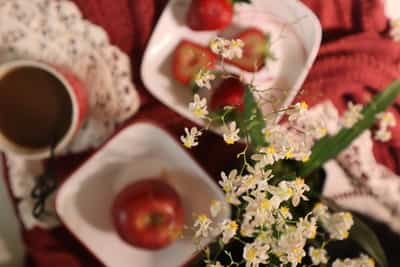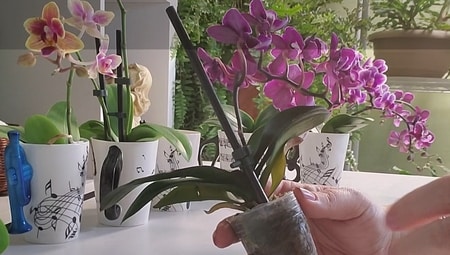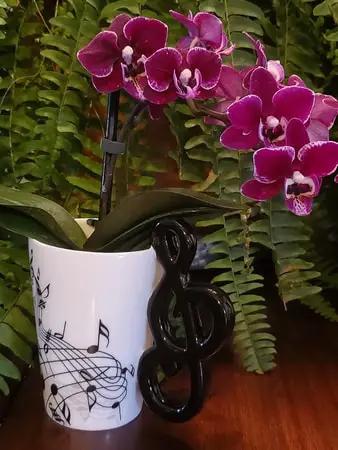The first step in your brand-new orchid care is to examine your orchid, and this involves taking it out of the plastic pot it comes in. In this article, I’ll focus strictly on the plastic pot that comes with the orchid and what to do with it.
Remove the plastic pot from the orchid only after the orchid has bloomed and the blossoms have fallen off or wilted. Removing the plastic container and repotting your orchid will expose any problems or pests that are on the root system, allow a fresh change of potting media, and promote better health for your orchid.

Image Credit: Orchideria © 2020 All Rights Reserved.
You’ve just returned home with a brand-new orchid but this new plant has the fame of being finicky, troublesome, and outright hard to grow indoors. The good news is that what you’ve heard is only true if you don’t have the right information.
If this is your first orchid, then you might be wondering what to do with the plastic that comes around it, when to repot it, what the stuff is inside the pot and a thousand other questions that are related to your new plant.
There are other reasons you should remove the plastic from your orchid, so let’s dive in to understand why, one by one.
1. Removing the Plastic Container Exposes Potential Orchid Root Problems
When you first purchase your orchid, you have no idea what the root system looks like. It might be healthy, with thick, luscious, green roots, or it might be already brown and mushy, with decomposing roots. There is absolutely no way of knowing what kind of roots you have if you don’t remove the plastic pot and go digging inside the root system.
Some older orchids might have what is called a plug in the center of the root system. This is a smaller, compact ball of sphagnum moss that the orchid was first planted in. To not use a lot of potting media, the nurseries and garden centers replant the orchid but don’t replace the old sphagnum moss. Over time, this plug decomposes.
Sphagnum moss only lasts around 1-2 years at most. Good quality Sphagnum might last 3, but mine never have. When sphagnum moss decomposes, it raises the pH in the potting media. A pH that is off will promote root decay quickly. It also becomes compacted, inhibiting airflow to the roots.
As soon as you can, take the outer plastic pot off the orchid roots and take off all the inner sphagnum moss carefully. Remove all the potting media it came in. Don’t be worried that you’ll hurt the roots by exposing them. 80% of orchids grow attached to trees, so their roots naturally grow in the air.
Another item to look for when examining the roots of your orchid, is to look for pests and insects. If you don’t remove the plastic from the orchid, you’ll not know what lurks beneath the surface.
Mealybugs, spider mites, thrips, aphids, and all kinds of little critters might be inhabiting the potting media. When you remove the plastic pot, verify that the roots are free of anything that moves.
By the way, if you have bugs but don’t know what they are, check out these articles: common bugs in orchid bark, fungus gnats, and common bugs in sphagnum moss.

2. Removing the Plastic Promotes Air Circulation
Some orchid vendors, especially big box stores and supermarket dealers, sell their orchids in a potting medium that is only good for a limited time. This brownie-like peat moss is not made to provide good air circulation and absorbs more water than other traditional potting media. This media is manufactured because of the ice cube watering method, which I do not support or promote. You can read why in this article.
This media is specifically made to hold water that drips over a constant period of time (as the ice cube melts), retaining it longer in the media. When changing the watering methods, which you should, you will also need to change potting media.
You might be wondering what all this has to do with the plastic around the orchid pot. Most ice cube method orchids use a thicker plastic that does not have many holes in it.
In fact, it looks like a sturdy drinking cup that has thick sides. This plastic vase has very few holes at the bottom because the media is not made to receive air and dry out quickly. Yet that is exactly what your orchid needs. It needs airflow and abundant air circulating around the roots and leaves.
The plastic that it comes in will maintain the orchid healthy for about four to five months, but after that time, the orchid’s roots will start to rot. Airflow is crucial in orchid care, and you need to replace the plastic container with a pot that has lots of slots, holes, vents, or other decorative methods that allow air to enter and exit the pot freely.
3. Removing the Plastic Pot After Transport
If you buy your orchids online (I have a page about how to do that successfully with hints and tips) they will probably come in pure sphagnum moss. Some orchid sellers will ship bare-rooted, and in this case, there is no issue. Yet when they come in pure sphagnum moss and happen to be watered before shipping, this water-logged plant will be hurting to get some air.
I’ve had a seller ship some orchids to me and the roots were sopping wet, dripping with excess water. Needless to say, most of the roots took a hit and died. I managed to save those orchids, but I certainly don’t use that seller anymore.
If your orchid is sold in a plastic container containing pure sphagnum moss then you’ll want to remove that plastic as soon as possible. It doesn’t matter if the orchid is in bloom or not at this point.
Get air to the roots because even though the orchid has been through a lot with transport. It’s better that the roots have a good growing medium than to lose the orchid entirely.

4. Decorative Plastic Around the Orchid will Inhibit Sunlight
If you purchased a mini orchid that comes in an adorable teacup or a coffee mug, the plastic it comes in might be flimsy in itself when removed from the decorative vase.
I know that the coffee mug was just adorable, yet, your orchid will not do it’s best in that ceramic or porcelain pot. Orchid roots need to be exposed to air and sunlight, since unlike other household plants roots, they photosynthesize. Orchid roots need access to light, air, humidity, and plenty of water. Inside the cute decorative vase, they won’t receive any of those necessities.
Many times, the wobbly plastic that the orchid comes in is just to accommodate the root ball inside the decorative vase. It won’t even stand up by itself. In this case, you’ll need to remove the plastic entirely and change the vase to a slotted pot that lets air circulate. My suggestion for good pots is this one found on Amazon (Affiliate Link).
If it is a mini Phalaenopsis orchid, the best potting media is super-fine grade bark, sphagnum moss, small charcoal chunks, and perlite.
I’ve also grown min’s in just Sphagnum moss, which do well too, but the pots are slotted seedling holders like this one (Affiliate Link) that are more empty space than air. This works because pure sphagnum moss retains so much water that it is hard to maintain dry at times.
that are more empty space than air. This works because pure sphagnum moss retains so much water that it is hard to maintain dry at times.
Some floral designs will sell orchids in a glass that is tinged, painted, or stained. Even though they are fascinating, these vases also inhibit proper light and the roots will suffer from it.
You can use terracotta pots, as long as you have an extremely healthy leaf system on your orchid. There is more about terracotta pots in this article.
5. Removing the Plastic Pot For a Repot
If the orchid is doing well and you don’t want to touch the roots while the orchid is in bloom, then you’ll need to wait to remove the plastic pot when it’s time to repot. Unlike household plants, orchids need to have a complete change in potting medium around 2-3 years. If it is just pure sphagnum moss, then the repotting time needs to be sooner, around a year.
It’s a wise decision to wait to repot the orchid after all the blooms have wilted and fallen off. Repotting orchids is always a stressful event for the plant and will set it back a bit. Yet due to the potting media decomposing, repotting orchids needs to be done.
Your orchid has produced tremendous amounts of energy to produce the bloom and if you repot it while in bloom, the stress levels go through the roof. This can cause bud blast, which is when the buds fall off the orchids.
Now the orchid, which is already on a low energy level, has to deal with adjusting to the new media, repairing damaged roots, and finding stability in its new pot—all this along with sustaining a flower spike.
If you can, wait until the flowers drop off. Phalaenopsis orchids do not have a period of dormancy, but they will not grow as much as soon as the flowers drop. This is the perfect time to remove that old plastic pot and get a new one, which is much more appropriate for the orchid. If you want the step by step on how to repot an orchid, this article I wrote might help. In summary, removing the plastic is an excellent way to promote good health for your orchid, as long as it is done at the appropriate time and replaced with something that is better.
The roots get a complete “physical”, as you look for pests, bugs, insects, and critters. You can also remove any damaged roots at this time.
By removing the plastic vase as soon as you get home, the orchid also gets a decent potting media. The old plug is removed and replaced with fresh media that will allow water to enter and exit the pot freely.
Don’t Stop Learning!
If you want to be included in more information and get a 14-page fertilization guide, please sign up for my newsletter. I don’t spam, but send emails out bi-monthly with some curious topics of interest. If you want more information, click here to go to a specific page on this website where I explain it more in detail.

Also, if you are looking for an orchid journal to keep your notes specifically about orchid care, check out my 2 solutions for that on this page. If note-keeping isn’t your thing, then there is a free excel spreadsheet that you can download. Click here for more information on how to do that.
If you subscribe to my newsletter, I will send you a 14-page guide on the main tips of orchid fertilizer. It is downloadable and you can print it out on your computer. I designed the guide to double up as a coloring book, just to make it fun.
If you have any questions or if there is something that I didn’t explain well, please feel free to leave a comment below.
Happy Cultivating!


I received a mini phalaenopsis for Easter. It is in full bloom, I pulled off the plastic pot. Roots are healthy but it is only the plug. Will it be ok till it is finished blooming before I repot
Hi Mona,
Yes, it will be fine if you wait until the blooms fall off. It’s actually better if you wait than if you repot it now.
-Amanda
I got a orchard for Mother’s Day it’s in a plastic bag inside of a ceramic pot. Do I take it out of that bag and put it into the pot? It’s in full bloom right now
Hi Donna,
Yes, you can take it out of the bag but leave it in it’s natural pot. After the blooms fall off, you can repot it.
-Amanda
I bought an orchid that has a clear plastic open ended sleeve to protect it for travel. I am giving for a gift in 5 days. Should I remove the orchid from this plastic sleeve right away or can it stay in until I gift it?
Hi Pat,
In this case, you can keep the plastic on your orchid. The 5 days won’t be a problem.
-Amanda
Do you have a recommendation for some clear pots suitable to repot orchids into?
Hi Lori,
I really like the pots form Orchid Supply store. I found that they are resistant, have slots, and are very reasonably priced. https://orchidsupplystore.com/3-inch-slot-plastic-pot/ Here is a link to the 3 inch pot, but look around to see what is best for your orchid’s size.
VERY helpful to this 85 year old living on Guam and learning about my orchids.
WHERE can I sign up for Everything you publish?
Received orchids from Hawaii. Took out of plastic pot and planted in spagham moss this morning. Didn’t realize I should’ve used orchid bark for repotting. Should I go ahead and repot now in bark or leave in spaghum moss till finished flowering? I’m sure it’s in BIG shock already. HELP!
What kind of soil should I use to repot my orchid? Mine came in a plastic container inside of a pot.